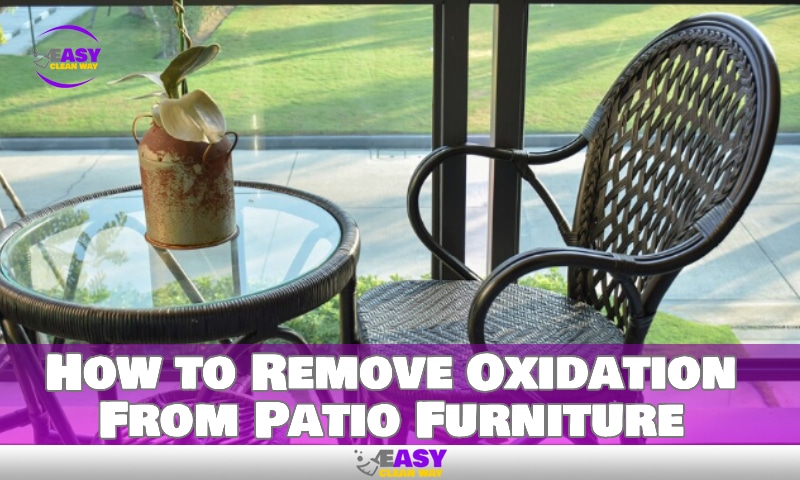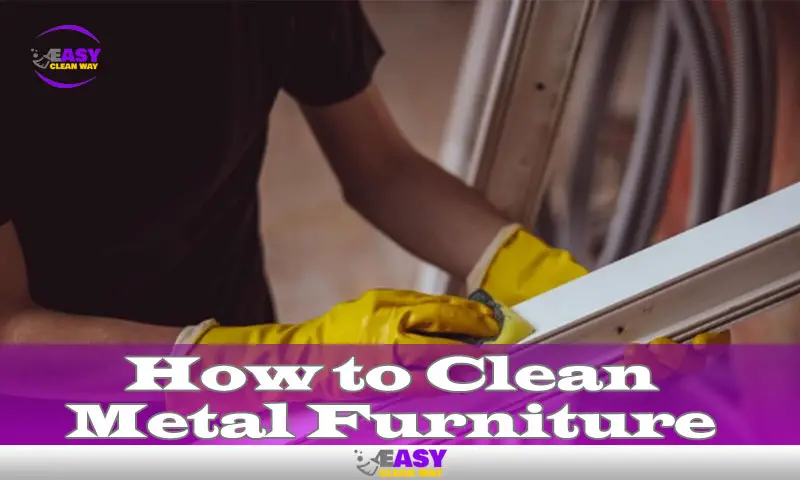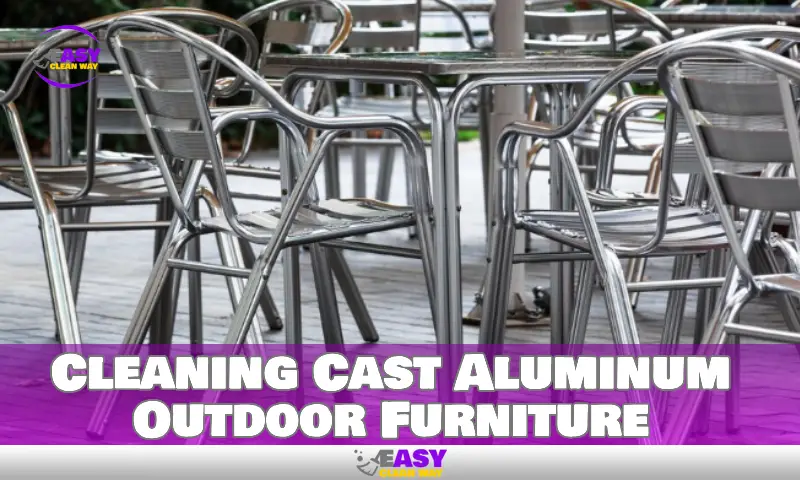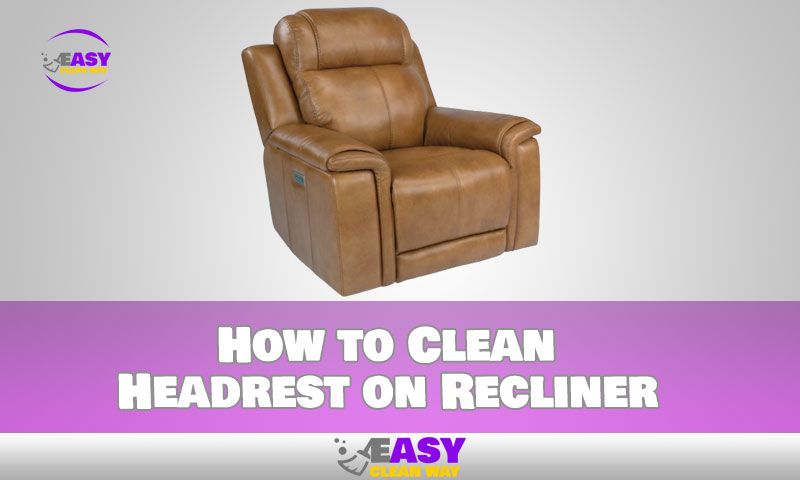Is your patio furniture looking a little dingy and worn? Over time, being exposed to the elements can cause metal patio furniture to develop oxidation, which shows up as rust, discoloration, or flaking. While oxidation is a natural process, that doesn’t mean you have to put up with ugly, weathered patio sets.
The good news is that you can often remove oxidation and restore patio furniture to its original look. All it takes is a little cleaning work and the right products. In this blog post, I’ll walk you through some simple techniques for getting patio furniture to look new again.
Understanding Oxidation On Patio Furniture
Understanding oxidation on patio furniture: oxidation is a natural process that occurs when the metal on your patio furniture reacts with oxygen in the air. This reaction forms a layer of rust or corrosion, which can tarnish the appearance of your furniture.
Oxidation not only affects the aesthetic appeal of your patio furniture but can also weaken its structure over time. It is important to remove oxidation to prolong the lifespan of your furniture and maintain its beauty. Regular cleaning and maintenance can help prevent oxidation, but if it has already occurred, you can use a combination of cleaning agents and tools specifically designed to tackle rust and corrosion.
By removing oxidation, you can restore the original shine and extend the longevity of your patio furniture. Don’t let oxidation spoil your outdoor space, take the necessary steps to keep your furniture looking brand new.
Preparing For Oxidation Removal

Preparing to remove oxidation from your patio furniture requires gathering the necessary tools and materials. Before starting, make sure to clean the furniture thoroughly. Assess the extent of the oxidation damage to determine the best course of action.
Homemade Solutions For Oxidation Removal
Oxidation on patio furniture can be effectively removed using homemade solutions. One option is to create a vinegar and baking soda mixture. Another remedy is to make a paste using lemon juice and salt. Additionally, you can try using Coca-Cola and aluminum foil.
These methods are simple yet highly effective in eliminating oxidation. Using the vinegar and baking soda mixture, apply it to the affected area and scrub gently. Similarly, with the lemon juice and salt paste, spread it over the oxidation and let it sit for a while before rinsing.
For the Coca-Cola and Aluminum Foil Method, soak the aluminum foil in Coca-Cola and scrub the furniture. With these homemade solutions, your patio furniture will be free from oxidation and will look as good as new.
Commercial Products For Oxidation Removal
Oxidation can be a common problem with patio furniture, but there are commercial products available that can effectively remove it. Rust removers and cleaners are designed to tackle tough oxidation on metal surfaces. They can penetrate deep into the rust and break it down, making it easier to remove.
Oxidation removal sprays are another option. These sprays are formulated to dissolve rust and oxidation upon contact, leaving your patio furniture looking clean and restored. Additionally, using metal polishes and protectants can help prevent future oxidation. These products create a protective barrier on the metal surface, shielding it from moisture and other elements that can cause oxidation.
By using these commercial products, you can restore the beauty of your patio furniture and extend its lifespan. Keep in mind that it’s important to follow the instructions on the product labels to ensure safe and effective use.
Step-By-Step Process For Removing Oxidation
To remove oxidation from patio furniture, start by applying your chosen cleaning solution to the affected areas. Then, gently scrub the oxidized spots using a soft brush or sponge. Be thorough, and make sure to cover all the oxidized areas.
Once you’ve scrubbed the furniture, rinse it thoroughly with water to remove any residue. After rinsing, make sure to dry the furniture completely before using it again. This will prevent any further damage or oxidation. Regular maintenance and cleaning will help keep your patio furniture looking new and free from oxidation.
Remember to choose a cleaning solution that is safe for the material of your furniture to avoid any damage. By following these steps, you can easily remove oxidation and keep your patio furniture in great condition.
Special Techniques For Specific Materials
For aluminum furniture, mix equal parts white vinegar and water in a spray bottle. Spray the solution onto the oxidized areas and let it sit for 10-15 minutes. Scrub gently with a soft-bristled brush, then rinse thoroughly with water. For wrought iron furniture, use a wire brush to remove loose rust and oxidation.
Next, apply a rust converter or primer to the affected areas, following the product instructions. After the primer has dried, apply a coat of paint to protect the furniture from further oxidation. When dealing with steel or cast iron furniture, start by scrubbing the oxidized areas with a wire brush to remove loose rust.
Then, apply a rust remover with a cloth or sponge, following the product instructions. Rinse off the rust remover and allow the furniture to dry before applying a protective coating or paint. With these specific techniques for each material, you can effectively remove oxidation and restore the beauty of your patio furniture.
Preventing Oxidation In The Future
Patio furniture can be prone to oxidation, but there are ways to combat this issue. One effective method is to apply protective coatings or sealants to the furniture. This creates a barrier that helps prevent oxidation from occurring in the future.
Regular cleaning and maintenance are also crucial to preventing oxidation. This includes wiping down the furniture regularly to remove dirt and debris. Additionally, storing the furniture properly during harsh weather conditions can help prolong its lifespan and prevent oxidation.
By following these guidelines, you can keep your patio furniture looking great for years to come.
Risks And Precautions

Oxidation can cause damage to your patio furniture’s surface, so it’s crucial to take precautions. Using the proper safety equipment, such as gloves and goggles, is essential during the oxidation removal process. Avoiding damage to your furniture’s surface is key when removing oxidation.
FAQ
How Do You Remove Oxidation From Patio Furniture?
To remove oxidation from patio furniture, use a mixture of white vinegar and water, scrub gently, and rinse with a hose.
What Causes Oxidation On Patio Furniture?
Patio furniture oxidizes over time from exposure to air and moisture, which causes the metal’s protective coating to break down.
Can Lemon Juice Remove Oxidation From Patio Furniture?
Yes, lemon juice can help remove oxidation from patio furniture due to its acidic properties. Apply it to the affected area and scrub gently.
Is It Possible To Prevent Oxidation On Patio Furniture?
Yes, you can prevent oxidation on patio furniture by regularly cleaning and maintaining it, applying protective coatings, and storing it indoors during harsh weather conditions.
Conclusion
To ensure that your patio furniture remains in top condition, it is important to take the necessary steps to remove oxidation. By following the tips outlined in this blog post, you can easily revitalize your furniture and maintain its beauty for years to come.
Start by assessing the extent of the oxidation and selecting the appropriate cleaning solution or product. Remember to always wear protective gear and work in a well-ventilated area. Use a gentle scrub brush or cloth to remove the oxidation, making sure to rinse thoroughly.
For stubborn stains, consider using a mixture of lemon juice and baking soda. Finally, apply a protective sealant or polish to prevent future oxidation. With a little time and effort, you can restore your patio furniture to its original luster and enjoy outdoor gatherings in style.
Hey there! I’m Alton Smith, your Clean Expert blogger. I’m on a quest to help you conquer chaos and embrace the joys of a tidy life.





